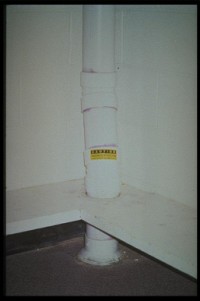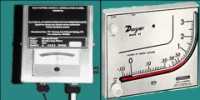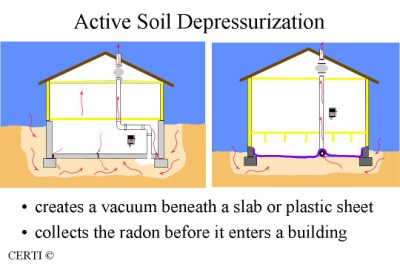Radon Mitigation
All Homes Can be Fixed
Reliable techniques exist for reducing radon levels in homes. Experience with radon mitigation systems has developed to the point that virtually any home can be fixed, either by a trained radon contractor, or in some cases, by homeowners who accomplish the repairs themselves.
Radon Mitigation Key Elements
-
- The system should be installed in accordance with the U.S. EPA’s Radon Mitigation Standards if no local building codes exist. The EPA model standards provide helpful, specific guidance. For example:
- The discharge shall be at least 10 feet above grade, 10 feet away from an opening which is two feet below the discharge, and above or at the eave of the roof.
- If the exhaust pipe is routed outside the home, the discharge must still meet the above criteria
- System fans should not be located inside the home or in a crawlspace. They can be in an attic, outdoors, or in a garage, provided there is no living space above the garage.
- There should be an indicator located in a prominent place that will easily let the occupant know if the system is functioning properly.
- Power to the fan should be supplied in accordance with local electric codes; including permits where required.
- All portions of the system are to be labeled and a simple instruction manual, with warranties, provided to the homeowner.
- All homes with mitigation systems should be retested no sooner than 24 hours nor later than 30 days after installation, to verify reduction. The home should also be retested every two years.
Topics
- How do I treat radon?
- Active Soil Depressurization
- Crawl Spaces
- Slab on Grade Homes
- Drainage Systems
- Under Slab Ductwork
- Piping
- Fans
- System Indicators
- Air Filtration Systems
- How much does a mitigation system cost?
- How do I find a qualified radon mitigation contractor?
Research by public and private agencies, combined with years of extensive hands-on mitigation experience and long-term follow-up studies on the durability of mitigation systems form a strong knowledge base of proven mitigation techniques. The techniques are straightforward and, for a typical single family residence, can be done in one day by a qualified contractor. Radon reduction requires more than just sealing cracks in a foundation. In fact, caulking and sealing of foundation openings, on its own, has proven NOT to be a reliable or durable technique. However, sealing is done in conjunction with other mitigation steps.
Active soil depressurization (ASD) has proven to be a very cost-effective and reliable technique for radon reduction. ASD systems collect the radon from beneath the building before it can enter. The systems can be simple or complex depending upon the design of the building. Operating costs of the system fans are modest, due to their low power consumption (typically less than 90 watts per fan).
The system draws the radon-laden soil gas from beneath the foundation and exhausts it outside of the building, far enough away from windows and other openings that it will not reenter. The system typically consists of a plastic pipe connected to the soil either through a hole in a slab floor, through a sump lid connection, or beneath a plastic sheet in a crawl space. Attached to the pipe is a quiet, continuously operating fan that discharges the radon outdoors.
The system’s design depends on the construction of the home, rather than the indoor radon concentrations. For example, a home with more than one foundation can present challenges to collecting the soil gas from under all portions of the building. However, trained mitigation contractors can sometimes connect multiple systems together so that only one fan system is required.
This kind of mitigation system also helps reduce moisture in the crawl space.
 A length of perforated pipe is laid on top of the soil running the length of the crawl space. The pipe will collect the radon from beneath the plastic sheeting when connected to a fan.
A length of perforated pipe is laid on top of the soil running the length of the crawl space. The pipe will collect the radon from beneath the plastic sheeting when connected to a fan.
Perforated pipe used to collect soil gas laid on floor of crawl space
A high density, cross laminated polyethylene sheeting is then laid on the soil. This type of sheeting is very durable and resists tearing.
High density polyethylene lay on dirt with edges and seams sealed
The seams should be overlapped and sealed. The edges should also be sealed to the walls of the crawl space, to ensure system efficiency and to help keep the plastic stationary. The use of a durable plastic prolongs the life of the system and may allow storage in the crawl space.
After the plastic has been installed, a solid PVC pipe is connected to the perforated pipe beneath the plastic. The PVC pipe is then routed to the radon fan.
 At least one four to six inch hole is cored (drilled) through the slab. A small pit is hollowed out beneath the hole, and a PVC pipe is inserted. This pipe is routed to a fan that creates a vacuum beneath the slab. The number of suction points depends on the permeability of the soil beneath the slab and the number of footings within the building.
At least one four to six inch hole is cored (drilled) through the slab. A small pit is hollowed out beneath the hole, and a PVC pipe is inserted. This pipe is routed to a fan that creates a vacuum beneath the slab. The number of suction points depends on the permeability of the soil beneath the slab and the number of footings within the building.
A single radon vent pipe is often all that is required in a residence. A general “rule of thumb” suggests the use of one vent pipe for roughly ever 2,000 square feet of floor space at ground level.
For a home that has a slab-on-grade or a basement, suction through a hole in the slab is applied. Radon-laden soil gas is drawn laterally through the rock and soil beneath the slab and then exhausted outside. The more permeable the soil, the better the system works.
If the soil is tightly compacted or if there are obstructions such as intermediate foundations under the slab, more than one suction point may be needed. If multiple suction points are needed, they can often be connected to a single depressurization fan.
 Homes that have sumps or French drains for control of rainwater can be effectively mitigated utilizing the sump to collect radon from the underlying soil. Two types of drainage systems can be readily adapted to collect radon from the soil below a house and exhaust it safely outside.
Homes that have sumps or French drains for control of rainwater can be effectively mitigated utilizing the sump to collect radon from the underlying soil. Two types of drainage systems can be readily adapted to collect radon from the soil below a house and exhaust it safely outside.
When the drainage system includes a sump, a lid with vent piping is placed on the sump pit. A radon fan connected to the vent pipe is used to draw radon from the soil and through the sump, to an outside exhaust point above the home’s roof. When placing a lid on the sump pit, it is important to remember to allow for future removal of the lid, to allow servicing of the sump pump.
The second technique for using a drainage system works well when there is no sump but a foundation drain is in place that runs to daylight. A saddle can be used to tie into the drain and connect it to a pipe and fan. The pipe continues to a safe discharge point. Special check valves are used to seal the daylight end of the foundation drain. These check valves allow the fan to create a vacuum at the same time they allow water to drain. When using a drainage system to collect radon it is important to maintain the drainage characteristics of the drainage system.
In some homes, return-air ductwork for the forced-air conditioning system is located beneath a slab floor. Although this can increase usable interior space and reduce the noise of recirculating air inside the home, the sub-floor ductwork, if unsealed, can add to radon problems. When the air conditioner fan is on, a fairly large vacuum created in the buried ductwork can draw radon-laden soil gas through the ducts and into the living space.
Even with this type of construction, there are effective ways to reduce radon. For example, if a house has a sump, a four-inch pipe connected to a sealed lid on the sump can route incoming soil gases to the radon fan. If the house has a perimeter foundation drain (French Drain), the vent pipe can be connected to the drain, taking care not to interfere with water drainage or sump pump function.
However, many homes have a slab floor; most of them without sumps or French Drain. For those houses, radon drawn inside through sub-floor ducts may require extra attention.
Radon laden soil can be drawn into a home through very small openings in the ductwork, especially when a forced air unit sits over a large opening in the slab.
Not all homes that have air return ducts under the slab floor will have radon concerns. The only way to know is to test. If a long-term test confirms elevated radon levels in a home that also has under-slab air returns, the following options should be considered.
- Removal and replacement of ductwork
This is the last resort and very expensive. Although some contractors may recommend this solution first, it may be prudent to explore a few other options before replacing ductwork.

| Pipe Material: | PVC or ABX |
| Thickness: | Schedule 40 |
| Pipe Rating: | DWV (Cellular Core |
| Size: | Four-inch |
- Follow manufacturer’s recommendations when gluing pipe and fittings
- Slope pipe back to suction point to avoid build up of condensation (1/8″ per foot)
- Support pipe every eight feet, vertically and every six inches horizontally
- Place “Radon Deduction System” label on pipe on each level where visible
- Two 45 degree fittings can be used to offset pipe
- When penetrating fire walls with vent pipe, maintain fire wall rating with fire collars or appropriate fire caulk
- Allow 30″ of vertical space for installation of the fan in an attic
- Downspout (3″ x 4″) is used outside for aesthetic reasons
- Installed in attic, garage, or outside
- Must not be installed inside of house
- Quiet
- 60 watts operating
- 11 year expected life
- Discharge should be high to avoid radon entering building
- Minimum of 10 feet above grade
- 10 feet from any openings 2 feet below discharge
- Above eave
- 1/4 inch bird screen
The suction piping is connected to a radon fan that must be located in an unoccupied attic, a garage, The suction piping is connected to a radon fan that must be located in an unoccupied attic, garage, or outside the home. These fans are quiet and use about 60 watts of electricity. Because radon is constantly generated in the soil beneath the home, the fans should operate continuously.
The fan discharge is routed through the roof or along an outside wall to a high point on the house. It must be pointed upward to force the collected radon up and away from the home. It is very important that the discharge not be near the ground. Otherwise, the radon might re-enter the structure and increase the level of radon in the home. Radon concentrations in excess of 2000 pCi/L have been measured in some discharge pipes.
Rain caps interfere with system efficiency and are not needed. However, screens should be placed on the discharge to keep birds and squirrels from entering the pipe.

As part of the installation of a depressurization system, an indicator must be installed which will tell the homeowner if something has changed the performance of the system. This is in addition to retesting the home for radon after the installation and repeating this test at least every two years.
Since it is the decay products of radon that actually present the risk from elevated radon levels, some homeowners have installed high efficiency air filters (HEPA) in their homes to not only reduce the the amount of decay products, but also to reduce other airborne particulates that can complicate allergies. The reduction of radon by air filtration systems is a relatively new approach that can be accomplished by three different methods, depending upon the type of heating or air conditioning system you presently have.
| Heating or A/C System | Approach |
|
Connect air filtration system to return duct in a manner that takes a portion of the air stream, filters it and re-injects it into the return duct. |
|
Install a stand-alone central HEPA filtration system that circulates air from the inteior of the home, filters it, and routes it back into the home. |
|
Install console unti HEPA filter systems for each frequently occupied room |
Although it is typically more common that an active soil depressurization systems is installed, if you have allergies and your radon levels are relatively low, you may want to consider this approach. If you do, it is important to note the following:
- HEPA systems that connect to your furnace and/or air conditioner, or units that function as whole house filtration systems, should be installed by a qualified mechanical contractor.
- After installation, your home will need to be tested for radon decay products with a working level meter, to determine the effectiveness of the system.
- Radon will not be reduced, but the more harmful radon decay products will be reduced.
- The air filtration approach is appropriate for relatively low radon levels between 4 and 8 pCi/L.
How much does a mitigation system cost?
The cost of a radon mitigation system installed by a certified contractor can be $2,000 or more, although EPA often cites a national average of $1,200 to $1,500. The actual cost may depend on the contractor, the construction and foundation type of the home, location of the home site, and aesthetic factors. For instance, a vent-pipe system routed outside of the home may cost less to install than one routed through an interior closet and attic space. EPA suggests that you obtain bids from certified contractors and compare costs.
The cost of a mitigation system may vary according to the home’s design, size, foundation, construction materials and the local climate.
Part of the mitigation cost can depend upon what is required to conceal the system and maintain the aesthetic value of the home. For example, a retrofit system routed outside the house can reduce radon quite well, but it may not be as visually pleasing as one routed through an interior closet.
| Average US installation cost: | $1,200 |
| Average operating cost: | $3/mo |
| Expected life span of fan: | 11 years |
| Fan replacement cost: | $145 – $300 |
| Periodic maintenance: | None |
How do I find a qualified radon mitigation contractor?
To find qualified radon contractors, EPA recommends that you contact one or both of the two privately-run national certification programs listed below.
National Radon Proficiency Program (NRPP)
PO Box 2109; Fletcher, NC 28732
800-269-4174; 828-890-4117
National Radon Safety Board (NRSB)
PO Box 703; Athens, TX 75751
866-329-3474; 903-675-3748
www.nrsb.org
In addition to asking about a radon contractor’s training and credentials, homeowners should always:
- Ask for references;
- Require proof of certification, including agreement to follow protocols and codes of ethics;
- Ask for proof of insurance including workers’ compensation; and
- Ask for a concise contract
Selecting a Contractor Checklist


